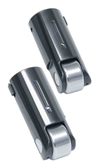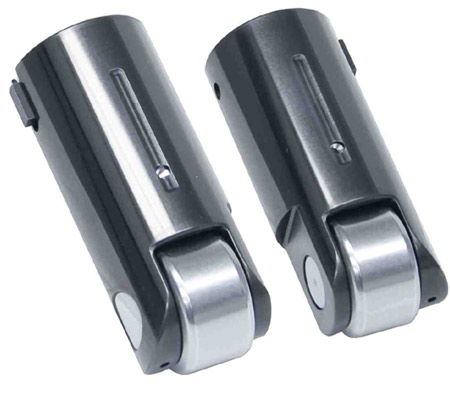Roller lifters
 In terms of circuit racing, the pushrod engine is most famously used in NASCAR competition; while some other race series allow all kinds of valve actuation, NASCAR mandates cam-in-block and overhead valve engine architecture. One aspect of valvetrain development that affects engine design and development engineers all over the world is valve lift profiles, and there has been a strong tendency over the years to design cam profiles that are more 'aggressive' in terms of using ever higher levels of acceleration and velocity.
In terms of circuit racing, the pushrod engine is most famously used in NASCAR competition; while some other race series allow all kinds of valve actuation, NASCAR mandates cam-in-block and overhead valve engine architecture. One aspect of valvetrain development that affects engine design and development engineers all over the world is valve lift profiles, and there has been a strong tendency over the years to design cam profiles that are more 'aggressive' in terms of using ever higher levels of acceleration and velocity.
For the top level of NASCAR racing - Sprint Cup - the governing body mandates the use of cam followers which are free to rotate within the lifter bores, and which therefore are cylindrical. NASCAR mandates flat-faced lifters having a maximum diameter of 0.875 in (22.22 mm). In the modern era, flat lifters are almost an anachronism; no new production pushrod engines have been designed around the flat follower for years, and nobody in racing would use them out of choice, as they limit valve opening velocities. In NASCAR, it is likely that the flat follower is used in order to limit development of better breathing engines, and hence limit engine output.
Roller lifters, which have at their nose a rolling element bearing, are less limited in terms of valve opening/closing velocities and so offer much more scope for development of valve lift profiles. A flat-faced lifter is limited in terms of lift velocity by its diameter; higher lift velocities require larger-diameter lifters. For every inch of lift per radian of cam rotation (one radian being about 57.3 degrees) the cam lobe-to-lifter contact will sweep out from the lifter axis by 1 in. With an infinitely thin cam, we can see that a Sprint Cup cam could only attempt to lift (or close) at a rate of 0.4375 in per radian. In reality, the maximum velocity used would be less than this, as it is common practice to maintain a certain percentage of the lobe width on the flat face of the lifter at maximum velocity.
With a flat-faced lifter, provided sensible contact stresses are maintained, acceleration causes no problem for the lifter. The roller lifter limiting velocity is a function of the pressure angle - that is, the angle between the normal to the contact and the axis of the lifter. The pressure angle is a function of both velocity and acceleration, and if this angle is too large, the lifter will tend to bind in the bore. There isn't room here to expand on the mathematics behind this, but it is sufficient to say that the valve lifting and closing velocities may be comfortably higher than with a flat-faced lifter.

A roller lifter may also be used at higher levels of stress without suffering surface fatigue of the cam or lifter. Lubricated rolling contacts can withstand much higher levels of stress; rolling element bearings are a prime example of this, with the surface stresses used routinely being in excess of the material's tensile strength. One cam manufacturer I spoke to in connection with an article on camshafts published in Race Engine Technology issue 48 said his recommended limiting stress for a roller lifter was more than twice his recommended limit for flat-faced or other lifters with simple sliding contacts.
There are though some disadvantages to a roller lifter. They are more complex, and therefore more expensive compared to a flat-faced type. They are also less stiff, owing to less direct load paths.
Fig. 1 - Roller lifters have a number of technical advantages over flat-faced lifters
Written by Wayne Ward